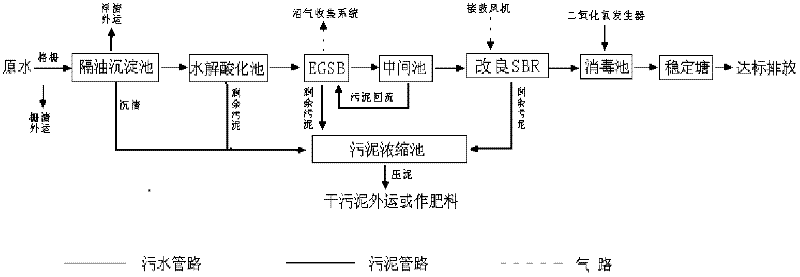Live pig slaughtering wastewater treating method
A technology for slaughtering wastewater and a treatment method, which is applied in the field of pig slaughtering wastewater treatment, and achieves the effects of good treatment effect, easy popularization and application, and low operating costs
- Summary
- Abstract
- Description
- Claims
- Application Information
AI Technical Summary
Problems solved by technology
Method used
Image
Examples
Embodiment Construction
[0028] The present invention will be further clarified through the detailed description of specific embodiments below, but it is not intended to limit the present invention, but only for illustration.
[0029] The present invention is implemented in a slaughterhouse that slaughters 100,000 live pigs a year. According to the combined process route of the present invention, a mechanical grid deslagging tank, an oil separation sedimentation tank, a hydrolytic acidification tank, an EGSB anaerobic reactor, and an intermediate sedimentation tank are built respectively. , Improved SBR ponds, disinfection ponds and stabilization ponds.
[0030] The slaughterhouse wastewater in this implementation, the daily wastewater treatment volume is 160m 3 , the wastewater quality is: COD 1200~1600mg / L, BOD 450~620 mg / L, NH 3 -N 65~72 mg / L, animal and vegetable oil 60~95 mg / L, number of coliform bacteria >1.6×10 7 a / L.
[0031]
[0032]
[0033] 1) Grille screen Grille: the grid spacing...
PUM
 Login to View More
Login to View More Abstract
Description
Claims
Application Information
 Login to View More
Login to View More - R&D
- Intellectual Property
- Life Sciences
- Materials
- Tech Scout
- Unparalleled Data Quality
- Higher Quality Content
- 60% Fewer Hallucinations
Browse by: Latest US Patents, China's latest patents, Technical Efficacy Thesaurus, Application Domain, Technology Topic, Popular Technical Reports.
© 2025 PatSnap. All rights reserved.Legal|Privacy policy|Modern Slavery Act Transparency Statement|Sitemap|About US| Contact US: help@patsnap.com


